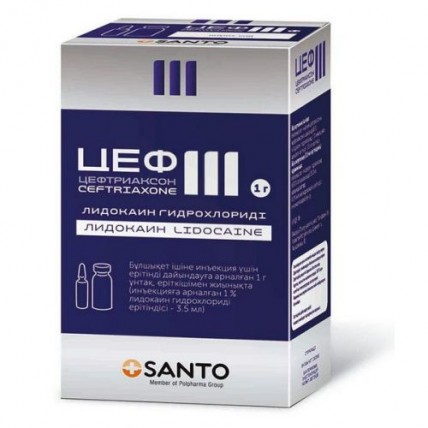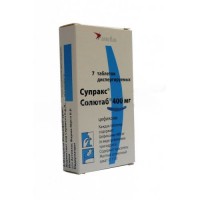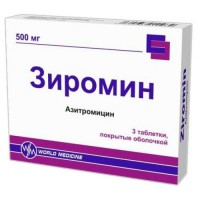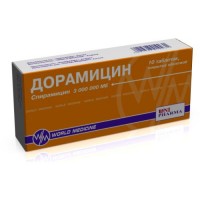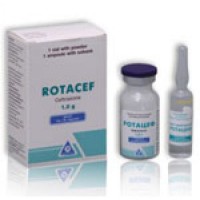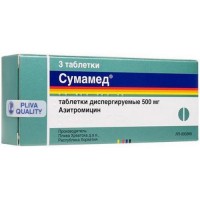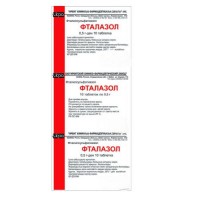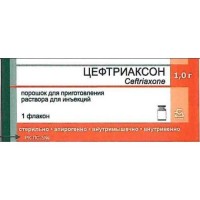III + Cef Lido 1's 1g powder to for solution preparation
- $11.30
The instruction for medical use of III®+ Tsef medicine Lido the Trade name Tsef of Lido's III®+ the International unlicensed name Tseftriakson Lekarstvennaya a form Powder for preparation of solution for intramuscular injections, 1.0 g complete with solvent (lidocaine a hydrochloride, solution for injections of 1% - 3.5 ml) Structure One bottle contains active agent - a tseftriakson of sodium (in terms of tseftriakson) 1.0 g, solvent Lidocaine a hydrochloride, solution for injections of 1% - 3.5 ml One ampoule (3.5 ml of drug) contains active agent – lidocaine a hydrochloride (in terms of 100% substance) 35.0 mg, excipients: 0.1 M hydroxide sodium solution, water for injections. The description Crystal powder from almost white till yellowish or yellowish-orange color, is slightly hygroscopic. Pharmacotherapeutic group Anti-infectious drugs for system use. Antibacterial drugs for system use. Beta laktamnye antibacterial drugs others. Cephalosporins of the third generation. Tseftriakson. The ATX J01DD04 code the Pharmacological Pharmacokinetics At properties parenteral administration tseftriakson well gets into fabrics and liquids of an organism. The bioavailability at intramuscular introduction is 100%. The maximum concentration in blood plasma at intramuscular introduction is reached in 2-3 hours. Reversibly contacts blood plasma albumine for 85-95% and this binding in inverse proportion to its concentration in blood. Tseftriakson well gets into all fabrics and liquids of an organism. Tseftriakson quickly diffuses in interstitial liquid where the bactericidal action concerning microorganisms, sensitive to it, keeps within 24 hours, well gets through a blood-brain barrier. Tseftriakson passes through a placental barrier and in small concentration gets to breast milk. After administration of drug in a dose of 1-2 g of concentration of a tseftriakson within 24 hours collect in various bodies, fabrics and liquids of an organism, including in lungs, heart, bilious ways, a liver, tonsils, a middle ear and mucous a nose, bones and also spinal, pleural, synovial liquids and a secret of a prostate. After intravenous use tseftriakson quickly gets into cerebrospinal fluid where bactericidal concentration concerning sensitive microorganisms remain within 24 hours. Tseftriakson gets through the inflamed meninx at children, including newborns. In 24 hours after intravenous administration in doses of 50-100 mg/kg of body weight (to newborns and babies, respectively) concentration of a tseftriakson in cerebrospinal fluid exceed 1.4 mg/l. The maximum concentration in cerebrospinal fluid is reached approximately in 4 hours after intravenous administration and makes, on average, 18 mg/l. In bacterial meningitis the average concentration of a tseftriakson in cerebrospinal fluid makes 17% of concentration in plasma, in aseptic meningitis - 4%. At adult patients with meningitis in 2-24 hours, after introduction of a dose of 50 mg/kg of body weight, concentration of a tseftriakson in cerebrospinal fluid many times over exceed the minimum overwhelming concentration for the most widespread causative agents of meningitis. The general plasma clearance of a tseftriakson is 10-22 ml/min. The renal clearance equals 5-12 ml/min. Elimination half-life makes about 8 hours at adult patients, at elderly 75 years – are more senior 16 hours. At adult persons of 50-60% of a tseftriakson 40-50% are removed in not changed form with urine, - with bile. At newborns about 80% of the entered dose of a tseftriakson it is removed by kidneys. In renal failures or a liver at adults the pharmacokinetics of a tseftriakson almost does not change (perhaps, insignificant lengthening of elimination half-life) thanks to redistribution of functions. If function of kidneys is broken, discharge with bile increases and if liver pathology takes place, then removal by kidneys amplifies. Pharmacodynamics Tsef III® - a tsefalosporinovy antibiotic of a broad spectrum of activity of the III generation. Has bactericidal effect due to oppression of synthesis of a cell wall of microorganisms. Tseftriakson possesses a broad spectrum of activity concerning gram-negative and gram-positive microorganisms. Vysokoustoychiv to the majority β-лактамаз (as penicillinases, and tsefalosporinaz), developed by gram-positive and gram-negative bacteria. Tseftriakson is usually active concerning the following microorganisms: Gram-positive aerobes of Staphylococcus aureus (Methicillinum - sensitive), Staphylococci coagulase-negative, Streptococcus pyogenes (ß - hemolytic, groups A), Streptococcus agalactiae (ß - hemolytic, groups B), ß - hemolytic streptococci (groups And, C), Streptococcus viridans, Streptococcus pneumoniae. Note. Staphylococcus spp Methicillinum-steady. rezistentna to cephalosporins, including to a tseftriakson. As a rule, Enterococcus faecalis, Enterococcus faecium and Listeria monocytogenes are also steady. Gram-negative aerobes of Acinetobacter lwoffi, Acinetobacter anitratus (mainly, A. baumanii) *, Aeromonas hydrophila, Alcaligenes faecalis, Alcaligenes odorans, alkaligenopodobny bacteria, Borrelia burgdorferi, Capnocytophaga spp., Citrobacter diversus (including C. amalonaticus), Citrobacter freundii *, Escherichia coli, Enterobacter aerogenes *, Enterobacter cloacae *, Enterobacter spp. (other) *, Haemophilus ducreyi, Haemophilus influenzae, Haemophilus parainfluenzae, Hafnia alvei, Klebsiella oxytoca, Klebsiella pneumoniae **, Moraxella catarrhalis (before Branhamella catarrhalis), Moraxella osloensis, Moraxella spp. (other), Morganella morganii, Neisseria gonorrhoeae, Neisseria meningitidis, Pasteurella multocida, Plesiomonas shigelloides, Proteus mirabilis, Proteus penneri *, Proteus vulgaris *, Pseudomonas fluorescens *, Pseudomonas spp. (other) *, Providentia rettgeri *, Providentia spp. (other), Salmonella typhi, Salmonella spp. (netifoidny), Serratia marcescens *, Serratia spp. (other) *, Shigella spp., Vibrio spp., Yersinia enterocolitica, Yersinia spp. Other. * Some isolates of these types are resistant to a tseftriakson, mainly, owing to education laktamaz, coded by chromosomes. ** Some isolates of these types are steady owing to formation of a number plazmido-mediated laktamaz. Note. Many strains of the above-stated microorganisms polyresistant to other antibiotics, such as aminopenicillin and ureidopenicillin, cephalosporins of the first and second generation and aminoglycosides, are sensitive to a tseftriakson. Treponema pallidum is sensitive to a tseftriakson. Clinical trials show what tseftriakson has good efficiency concerning primary and secondary syphilis. Behind very small exceptions, clinical P.aeruginosa isolates are resistant to a tseftriakson. Anaerobe bacterias of Bacteroides spp. (zhelchechuvstvitelny) *, Clostridium spp. (except for C. difficile), Fusobacterium nucleatum, Fusobacterium spp. (other), Gaffkia anaerobica (before Peptococcus), Peptostreptococcus spp. * Some isolates of these types are resistant to a tseftriakson because of education β-лактамаз. Note. Many strains of the β-lactamazoforming Bacteroides spp. (in particular, B. fragilis) are steady. Also Clostridium difficile is steady. Indications - sepsis, meningitis - disseminate borreliosis of Lyme (early and late stages of a disease) - lower respiratory tract infections (especially pneumonia) - infections of ENT organs - infections of abdominal organs (peritonitis, infections of biliary tract and digestive tract) - infections of bones, joints, soft tissues, skins, wound fevers - infections of kidneys and urinary tract - infections of genitals, including gonorrhea - infections at patients with the weakened immunity - preoperative prevention of infectious complications the Route of administration and doses the Dose depends on type, localization and weight of an infection, sensitivity of the activator, on age of the patient and a condition of functions of his liver and kidneys. The doses specified in the tables given below are the recommended doses for use at these indications. In especially hard cases it is necessary to consider expediency of purpose of the highest doses from the specified ranges. Adults and children are more senior than 12 years (the body weight & gt, 50 kg) the Dose * Frequency rate of use ** the Indication of 1-2 g of 1 times a day Not hospital pneumonia. Exacerbation of chronic obstructive pulmonary diseases. Intraabdominal infections. The complicated infections of urinary tract (including pyelonephritis). 2 g of 1 times a day Intrahospital pneumonia. The complicated infections of skin and soft tissues of the Infection of bones and joints. 2-4 g once a day to Patients with the neutropenia and fever caused by a bacterial infection. Bacterial endocarditis. Bacterial meningitis. * At the established bacteremia the highest doses from the specified range are considered. ** When prescribing drug in a dose of more than 2 g a day the possibility of use of drug 2 times a day is considered. Indications for adults and children are more senior than 12 years (& gt, 50 kg) which demand the special mode of administration of drug: Acute average otitis the Drug on 1 – 2 g is administered intramusculary once a day (each 24 hours). The daily dose of 1 - 2 g should be entered intramusculary within 3 days. Preoperative prevention of surgical infections Single introduction before operation in a dose of 2 g. Gonorrhea introduction Single intramusculary in a dose of 500 mg. The Recommended doses of 0.5 g or 1 g increase syphilis to 2 g once a day in neurosyphilis, duration of treatment of 10-14 days once a day. Recommendations about a dosage in syphilis, including in neurosyphilis, are based on limited data. It is necessary to take national and local leaders into account. A disseminate Lime borreliosis (early (O) and a late (III) stage) to Apply in a dose 2 g within 14-21 days once a day. The recommended duration of treatment varies. It is necessary to take national and local leaders into account. Use for children Newborns, babies and children from 15 days to 12 years (& lt, 50 kg) the Dose * Frequency rate of use ** Indications of 50-80 mg/kg of body weight of 1 times a day the Intraabdominal infection. The complicated infections of urinary tract (including pyelonephritis). Not hospital pneumonia. Hospital pneumonia. 50-100 mg/kg of body weight (the maximum dose - 4 g) 1 time a day the Complicated infections of skin and urinary tract. Infections of bones and joints. To patients with a neutropenia with the fever caused by a bacterial infection. 80-100 mg/kg of body weight (the maximum dose - 4 g) 1 time a day Bacterial meningitis. 100 mg/kg of body weight (the maximum dose - 4 g) 1 time a day the Bacterial endocarditis. * At the established bacteremia the highest doses from the specified range are considered. ** When assigning a dose of more than 2 g a day the possibility of use of drug 2 times a day is considered. Indications for newborns, babies and children from 15 days to 12 years (& lt, 50 kg) who demand the special mode of administration of drug: Acute average otitis As a rule, rather single intramuscular administration of drug in a dose of 50 mg/kg of body weight. Limited data demonstrate that in hard cases or in the absence of effect of the previous therapy, there can be effectively intramuscular introduction of a tseftriakson in a dose of 50 mg/kg a day within 3 days. Preoperative prevention of surgical infections Single introduction before operation in a dose of 50-80 mg/kg of body weight. Syphilis the Recommended doses of 75-100 mg/kg of body weight once a day, duration of treatment of 10-14 days. Recommendations of a dosage in syphilis, including in neurosyphilis, are based on limited data. It is necessary to take national and local leaders into account. A disseminate Lime borreliosis (early (O) and a late (III) stage) to Apply in a dose 50-80 mg/kg of body weight within 14-21 days once a day. The recommended duration of treatment varies. It is necessary to take national and local leaders into account. Newborns at the age of 0-14 days Tseftriakson is contraindicated to premature newborns aged up to 41 weeks (week of pregnancy + weeks after the birth). A dose * Frequency rate of use of the Indication of 20-50 mg/kg of body weight of 1 times a day Intraabdominal infections. The complicated infections of skin and soft tissues. The complicated infections of urinary tract (including pyelonephritis). Not hospital pneumonia. Hospital pneumonia. Infections of bones and joints. To patients with a neutropenia and fever the caused bacterial infection. 50 mg/kg of body weight of 1 times a day Bacterial meningitis. Bacterial endocarditis. * At the established bacteremia the highest doses from the specified range are considered. Not to exceed the maximum daily dose of 50 mg/kg of body weight. Indications for newborns at the age of 0-14 days which demand the special mode of administration of drug: Acute average otitis As a rule, rather single intramuscular administration of drug in a dose of 50 mg/kg of body weight. Preoperative prevention of surgical infections. Single introduction before operation in a dose of 20-50 mg/kg of body weight. Syphilis the Recommended dose of 50 mg/kg of body weight once a day, duration of treatment of 10-14 days. Recommendations about a dosage in syphilis, including in neurosyphilis, are based on limited data. It is necessary to take national and local leaders into account. Therapy duration Duration of therapy depends on a course of the disease. Use of a tseftriakson should be continued within 48-72 hours after normalization of body temperature of the patient or confirmation of an eradikation of the activator. Use for elderly people on condition of normal functioning of kidneys and a liver dose adjustment for patients of advanced age is not required. Use for patients with an abnormal liver function Is not present need of dose adjustment of a tseftriakson in a slight or moderate abnormal liver function on condition of normal function of kidneys. Researches on use of drug for patients with a heavy liver failure were not conducted. Use for patients with a renal failure patients have no need of dose adjustment of a tseftriakson with renal failures provided that function of a liver is not broken. In cases of a preterminal renal failure (clearance of creatinine & lt, 10 ml/min.) the dose of a tseftriakson should not exceed 2 g a day. It is not required from the patients who are on dialysis of additional administration of drug after the procedure. Tseftriakson is not brought by a peritoneal hemodialysis. Clinical control of safety and efficiency of drug is necessary. Use for patients with a heavy liver and renal failure At use of a tseftriakson for patients with a heavy renal and liver failure the clinical control of safety and efficiency of drug is necessary. A method of administration Tsef III® + Lido should be applied in the form of an intramuscular injection (deep injections). Intramuscular introduction should be carried out in large muscles, to enter no more than 1 g into one muscle. Children up to 15 years are forbidden to apply lidocaine as solvent for Tsef of Lido's III®+. At use of lidocaine as solvent at persons 15 years are more senior it is recommended to carry out intracutaneous allergy test on lidocaine. At use of lidocaine as solvent before administration of solution it is necessary to exclude at the patient of a contraindication to lidocaine use (see the instruction for use of lidocaine) and also considering allergic reactions to lidocaine in the anamnesis. At use of lidocaine as solvent the intravenous administration of the received solution is contraindicated! Tseftriakson is contraindicated to newborns in need of administration of drugs of calcium or kaltsiysoderzhashchy solutions because of risk of formation of precipitated calcium superphosphates of tseftriakson-calcium in lungs and kidneys. Because of risk of formation of a deposit for dissolution of a tseftriakson it is not necessary to use kaltsiysoderzhashchy drugs (Ringera solution, Hartman's solution). Also emergence of precipitated calcium superphosphates of calcic salts of a tseftriakson can happen when mixing drug to solutions, calciferous, in one infusional system for intravenous administration.
oety should not mix or to apply at the same time tseftriakson and solutions, calciferous. For preoperative prevention of surgical infections tseftriakson it is necessary to enter in 30-90 minutes prior to operation. Solutions of drug have to apply introduction at once after preparation. For intramuscular introduction of 1 g of drug dissolve 1% of solution of lidocaine in 3.5 ml and enter deeply into a gluteus. It is recommended to enter no more than 1 g into the same muscle. The solution containing lidocaine cannot be entered intravenously! Solutions of the drug Tsef III®+ Lido cannot be mixed or added to the solutions containing other antimicrobial drugs or solvents because of possible incompatibility. Side effects the Most frequent side effects: eosinophilia, leukopenia, thrombocytopenia, diarrhea, rash, increase in liver enzymes. Often - an eosinophilia, a leukopenia, thrombocytopenia - diarrhea, a liquid chair - increase in enzymes of a liver - skin rash Infrequently - a fungal infection of genitalias - a granulocytopenia - anemia - a coagulopathy - a headache - dizziness - nausea, vomiting - a skin itching - phlebitis - pain in the place of an injection - fever - increase in level of creatinine in blood Is rare - a pseudomembranous coloenteritis - a bronchospasm - a small tortoiseshell - a hamaturia, a glucosuria - a fever, hypostasis It is unknown - superinfection - hemolytic anemia - an agranulocytosis (& lt, 500/mm) - an acute anaphylaxis or anaphylactoid reactions, hypersensitivity - spasms - pancreatitis - stomatitis - a glossitis - a deposit in a gall bladder - kernikterus - Stephens-Johnson's syndrome, a syndrome of Layella / a toxic epidermal necrolysis, a multiformny erythema, sharp generalizirovanny exanthematous pustulez - an oligouriya - a deposit in kidneys (reversible) - false positive test results of Koombs and the test for a galactosemia, false positive results of definition of glucose Are registered by not euzymatic methods of the Infection and an invasion diarrhea cases after introduction of a tseftriakson which can be connected with Clostridium difficile, it is necessary to control the level of liquid and electrolytes in an organism. Sedimentation of calcic salts of a tseftriakson exceptional cases of heavy side effects, and in certain cases with a lethal outcome at the premature and full-term newborns (at age & lt, 28 days) to whom intravenously entered tseftriakson and calcium Are registered. After opening, not dissolved compounds of calcic salt of a tseftriakson in lungs and kidneys were found. Newborns are subject to higher risk of formation of precipitation that is connected with the small volume of blood and more long half-life period of a tseftriakson in comparison with adult patients. Very exceptional cases of formation of a deposit of calcic salt of a tseftriakson in kidneys are registered, generally at children gt, 80 mg/kg/days is more senior than 3 years to which entered or high daily doses of a tseftriakson (for example, &), or the total doses exceeding 10 grams and with other risk factors (for example, liquid restrictions, a bed rest, etc.) the risk of formation of a deposit increases at the lying or dehydrated patients. This side effect can proceed simptomno or asymptomatically, can lead to developing of a renal failure and an anury, but is reversible after the therapy termination tseftriaksony. Cases of formation of a deposit of calcic salt of a tseftriakson in a gall bladder, generally at the patients receiving the doses exceeding the recommended standard dose of a tseftriakson are registered. Prospective researches at children showed the variable frequency of emergence of a deposit after intravenous use of drug, in some researches more than 30%. It is probable that at slow infusional introduction (within 20-30 minutes) the frequency of cases of this side effect decreases. This side effect usually proceeds asymptomatically, but is rare in cases, formation of precipitation was followed by clinical symptoms, such as pain, nausea and vomiting. In these cases it is recommended to carry out symptomatic treatment. Formation of precipitation, as a rule, the reversible phenomenon which stops after treatment tseftriaksony. Contraindications - hypersensitivity to a tseftriakson, other cephalosporins or to any of excipients - heavy reactions of hypersensitivity (for example, anaphylactic reactions) on any other type beta laktamnykh antibacterial drugs (penicillin, monobaktama, karbapenema) in the anamnesis - newborns (especially premature) at risk of developing bilirubinovy encephalopathy - premature newborns aged up to 41 weeks (week of pregnancy + weeks after the birth) - the full-term newborns (aged up to 28 days) with jaundice, a hyperbilirubinemia or acidosis, owing to a possibility of disturbance of binding of bilirubin. Such patients have a risk of developing bilirubinovy encephalopathy. - if necessary (or the expected need) treatments by intravenous kaltsiysoderzhashchy solutions, including intravenous kaltsiysoderzhashchy injections, for example, parenteral nutrition, because of risk of formation of a deposit of calcic salts of a tseftriakson (especially at newborns) before an intramuscular injection of the drug Tsef III®+ Lido with lidocaine as solvent it is necessary to exclude the contraindications connected with administration of lidocaine. Lidocaine the containing solutions of the drug Tsef III®+ Lido cannot be entered intravenously. Medicinal interactions use of kaltsiysoderzhashchy solutions, such as Ringer or Gartman's solution, for cultivation of a tseftriakson or for further intravenous administration as the deposit can be formed is not allowed. Formation of a deposit of calcic salts of a tseftriakson can happen when mixing a tseftriakson and kaltsiysoderzhashchy solutions at use of one venous access. It is impossible to apply tseftriakson along with kaltsiysoderzhashchy solutions to intravenous administration, including with long infusions of kaltsiysoderzhashchy solutions, for example, at parenteral nutrition using the Y-connector. For all groups of patients, except newborns, perhaps consecutive administration of drug and kaltsiysoderzhashchy solutions at careful washing of infusional systems between injections by compatible liquid. Newborns are subject to the increased risk of formation of a deposit of calcic salts of a tseftriakson. At simultaneous use of oral anticoagulants and drug the risk of deficiency of vitamin K increases and bleeding can develop. It is necessary to control carefully INR (the international normalized relation) and to apply adequate dose adjustment of vitamin K in time and after drug treatment. Antagonistic effects at simultaneous use of drug with chloramphenicol were noted. At simultaneous use of high doses of drug and loopback diuretics (for example, furosemide), renal failures were not observed. Probenetsid does not influence removal of the drug Tsef III®+ Lido. The drug Tsef III®+ Lido is incompatible with amsakriny, Vancomycinum, flukonazoly and aminoglycosides. Special instructions As well as at use of other cephalosporins, were registered anaphylactic reactions, including from the death, even in cases when the patient had no allergic reactions in the anamnesis. Before use of the drug Tsef III®+ Lido it is necessary to establish whether were noted in the past at the patient of reaction of hypersensitivity to a tseftriakson, other cephalosporins, penicillin and beta laktamnym to antibiotics. With care appoint to patients at allergic reactions to medicines, other allergic diathesis in the anamnesis. At emergence of allergic reactions against the background of therapy, drug should be cancelled. The cases from the death connected with formation of precipitated calcium superphosphates of calcium with tseftriaksony in lungs and kidneys of the premature and full-term newborns aged up to 1 month are described. At least, one of them received tseftriakson and calcium at different times and through various venous accesses. The messages confirming formation of intravascular precipitated calcium superphosphates at patients except the newborns who received treatment tseftriaksony and kaltsiysoderzhashchy solutions or other kaltsiysoderzhashchy drugs are not found in available scientific data. At newborns calcium-tseftriakson in comparison with other age groups is raised risk of formation of precipitated calcium superphosphates. Despite availability of data on formation of intravascular precipitated calcium superphosphates only at newborns at use of a tseftriakson and kaltsiysoderzhashchy infusion solutions or any other kaltsiysoderzhashchy drugs, at patients of any age tseftriakson it is not necessary to mix or enter along with kaltsiysoderzhashchy infusion solutions, even applying various venous accesses. However at patients is more senior than 28-day age tseftriakson and kaltsiysoderzhashchy solutions can be applied consistently one by one if intravenous accesses on different parts of the body are applied or if infusional lines change or are completely washed out between injections by normal saline solution to avoid sedimentation. At patients who need continuous injection of kaltsiysoderzhashchy solutions it is necessary to consider the possibility of use of alternative antibacterial treatment which does not cause similar risk of precipitation. If use of a tseftriakson is necessary for the patients who are on long parenteral nutrition solution for parenteral nutrition and tseftriakson can be entered at the same time, but through various venous accesses on various sites. Alternatively, administration of solution for parenteral nutrition can be stopped for infusion of a tseftriakson. As well as at use of other cephalosporins, at the Tsef drug treatment III®+ Lido the development of autoimmune hemolytic anemia is possible. Hard cases of hemolytic anemia, including from the death were registered, during treatment of both adults, and children. Newborns with a hyperbilirubinemia and premature newborns it is not recommended to appoint drug newborn with a hyperbilirubinemia and the premature newborn as tseftriakson can force out bilirubin from communication with seralbumin, increasing risk of developing bilirubinovy encephalopathy at such children. At development in the patient who is on treatment tseftriaksony the anemia cannot exclude the diagnosis cephalosporin - the associated anemia and it is necessary to cancel drug treatment before clarification of the reason. Change of laboratory indicators In rare instances at patients false positive results of test of Koombs can be observed. False positive results can be received when determining glucose in urine therefore during therapy Tsef Lido's III®+ if necessary needs to determine a glucosuria only by a fermental method. An antibiotic - the associated colitis, pseudomembranous colitis As well as at use of the majority of other antibacterial drugs, at treatment Tsef Lido's III®+ registered cases of development of the diarrhea caused by Clostridium difficile (C. difficile), various weight: from slight diarrhea to colitis from the death. Treatment by antibacterial drugs suppresses normal microflora of a large intestine and provokes growth of C.difficile. In turn, C. difficile forms toxins A and B which are factors of pathogenesis of the diarrhea caused by C. difficile. S.'s strains of difficile which are hyper producing toxins are causative agents of infections with high risk of complications and mortality, owing to their possible resistance to antimicrobic therapy, treatment can demand colectomy. It is necessary to remember a possibility of development of the diarrhea caused by C. difficile at all patients with diarrhea after antibiotic treatment. Careful collecting the anamnesis since cases of developing of the diarrhea caused by C. difficile later after therapy are noted more than 2 months by antibiotics is necessary. At suspicion or confirmation of the diarrhea caused by C. difficile the cancellation of the current antibiotic treatment difficile which is not directed to S. perhaps will be required. According to clinical indications the corresponding treatment with input of the fluid and electrolytes, proteins, antibiotic treatment concerning S. difficile, surgical treatment has to be appointed. Due to the use of a tseftriakson, cases of the antibiotiko-associated diarrhea, colitis and pseudomembranous colitis were registered. These diagnoses have to be differentiated in case of development in the patient of diarrhea during or soon after the end of treatment. Administration of drug has to be stopped when developing heavy diarrhea and/or diarrhea with blood during use of drug and the corresponding therapy is appointed. Tseftriakson it is necessary to apply with care at persons with gastrointestinal diseases (especially colitis) in the anamnesis. As well as at treatment by other antibacterial drugs, at therapy Tsef of Lido's III®+ can develop superinfection. Prolonged use of a tseftriakson can bring to the overgrowth of not h
to Develop
oety should not mix or to apply at the same time tseftriakson and solutions, calciferous. For preoperative prevention of surgical infections tseftriakson it is necessary to enter in 30-90 minutes prior to operation. Solutions of drug have to apply introduction at once after preparation. For intramuscular introduction of 1 g of drug dissolve 1% of solution of lidocaine in 3.5 ml and enter deeply into a gluteus. It is recommended to enter no more than 1 g into the same muscle. The solution containing lidocaine cannot be entered intravenously! Solutions of the drug Tsef III®+ Lido cannot be mixed or added to the solutions containing other antimicrobial drugs or solvents because of possible incompatibility. Side effects the Most frequent side effects: eosinophilia, leukopenia, thrombocytopenia, diarrhea, rash, increase in liver enzymes. Often - an eosinophilia, a leukopenia, thrombocytopenia - diarrhea, a liquid chair - increase in enzymes of a liver - skin rash Infrequently - a fungal infection of genitalias - a granulocytopenia - anemia - a coagulopathy - a headache - dizziness - nausea, vomiting - a skin itching - phlebitis - pain in the place of an injection - fever - increase in level of creatinine in blood Is rare - a pseudomembranous coloenteritis - a bronchospasm - a small tortoiseshell - a hamaturia, a glucosuria - a fever, hypostasis It is unknown - superinfection - hemolytic anemia - an agranulocytosis (& lt, 500/mm) - an acute anaphylaxis or anaphylactoid reactions, hypersensitivity - spasms - pancreatitis - stomatitis - a glossitis - a deposit in a gall bladder - kernikterus - Stephens-Johnson's syndrome, a syndrome of Layella / a toxic epidermal necrolysis, a multiformny erythema, sharp generalizirovanny exanthematous pustulez - an oligouriya - a deposit in kidneys (reversible) - false positive test results of Koombs and the test for a galactosemia, false positive results of definition of glucose Are registered by not euzymatic methods of the Infection and an invasion diarrhea cases after introduction of a tseftriakson which can be connected with Clostridium difficile, it is necessary to control the level of liquid and electrolytes in an organism. Sedimentation of calcic salts of a tseftriakson exceptional cases of heavy side effects, and in certain cases with a lethal outcome at the premature and full-term newborns (at age & lt, 28 days) to whom intravenously entered tseftriakson and calcium Are registered. After opening, not dissolved compounds of calcic salt of a tseftriakson in lungs and kidneys were found. Newborns are subject to higher risk of formation of precipitation that is connected with the small volume of blood and more long half-life period of a tseftriakson in comparison with adult patients. Very exceptional cases of formation of a deposit of calcic salt of a tseftriakson in kidneys are registered, generally at children gt, 80 mg/kg/days is more senior than 3 years to which entered or high daily doses of a tseftriakson (for example, &), or the total doses exceeding 10 grams and with other risk factors (for example, liquid restrictions, a bed rest, etc.) the risk of formation of a deposit increases at the lying or dehydrated patients. This side effect can proceed simptomno or asymptomatically, can lead to developing of a renal failure and an anury, but is reversible after the therapy termination tseftriaksony. Cases of formation of a deposit of calcic salt of a tseftriakson in a gall bladder, generally at the patients receiving the doses exceeding the recommended standard dose of a tseftriakson are registered. Prospective researches at children showed the variable frequency of emergence of a deposit after intravenous use of drug, in some researches more than 30%. It is probable that at slow infusional introduction (within 20-30 minutes) the frequency of cases of this side effect decreases. This side effect usually proceeds asymptomatically, but is rare in cases, formation of precipitation was followed by clinical symptoms, such as pain, nausea and vomiting. In these cases it is recommended to carry out symptomatic treatment. Formation of precipitation, as a rule, the reversible phenomenon which stops after treatment tseftriaksony. Contraindications - hypersensitivity to a tseftriakson, other cephalosporins or to any of excipients - heavy reactions of hypersensitivity (for example, anaphylactic reactions) on any other type beta laktamnykh antibacterial drugs (penicillin, monobaktama, karbapenema) in the anamnesis - newborns (especially premature) at risk of developing bilirubinovy encephalopathy - premature newborns aged up to 41 weeks (week of pregnancy + weeks after the birth) - the full-term newborns (aged up to 28 days) with jaundice, a hyperbilirubinemia or acidosis, owing to a possibility of disturbance of binding of bilirubin. Such patients have a risk of developing bilirubinovy encephalopathy. - if necessary (or the expected need) treatments by intravenous kaltsiysoderzhashchy solutions, including intravenous kaltsiysoderzhashchy injections, for example, parenteral nutrition, because of risk of formation of a deposit of calcic salts of a tseftriakson (especially at newborns) before an intramuscular injection of the drug Tsef III®+ Lido with lidocaine as solvent it is necessary to exclude the contraindications connected with administration of lidocaine. Lidocaine the containing solutions of the drug Tsef III®+ Lido cannot be entered intravenously. Medicinal interactions use of kaltsiysoderzhashchy solutions, such as Ringer or Gartman's solution, for cultivation of a tseftriakson or for further intravenous administration as the deposit can be formed is not allowed. Formation of a deposit of calcic salts of a tseftriakson can happen when mixing a tseftriakson and kaltsiysoderzhashchy solutions at use of one venous access. It is impossible to apply tseftriakson along with kaltsiysoderzhashchy solutions to intravenous administration, including with long infusions of kaltsiysoderzhashchy solutions, for example, at parenteral nutrition using the Y-connector. For all groups of patients, except newborns, perhaps consecutive administration of drug and kaltsiysoderzhashchy solutions at careful washing of infusional systems between injections by compatible liquid. Newborns are subject to the increased risk of formation of a deposit of calcic salts of a tseftriakson. At simultaneous use of oral anticoagulants and drug the risk of deficiency of vitamin K increases and bleeding can develop. It is necessary to control carefully INR (the international normalized relation) and to apply adequate dose adjustment of vitamin K in time and after drug treatment. Antagonistic effects at simultaneous use of drug with chloramphenicol were noted. At simultaneous use of high doses of drug and loopback diuretics (for example, furosemide), renal failures were not observed. Probenetsid does not influence removal of the drug Tsef III®+ Lido. The drug Tsef III®+ Lido is incompatible with amsakriny, Vancomycinum, flukonazoly and aminoglycosides. Special instructions As well as at use of other cephalosporins, were registered anaphylactic reactions, including from the death, even in cases when the patient had no allergic reactions in the anamnesis. Before use of the drug Tsef III®+ Lido it is necessary to establish whether were noted in the past at the patient of reaction of hypersensitivity to a tseftriakson, other cephalosporins, penicillin and beta laktamnym to antibiotics. With care appoint to patients at allergic reactions to medicines, other allergic diathesis in the anamnesis. At emergence of allergic reactions against the background of therapy, drug should be cancelled. The cases from the death connected with formation of precipitated calcium superphosphates of calcium with tseftriaksony in lungs and kidneys of the premature and full-term newborns aged up to 1 month are described. At least, one of them received tseftriakson and calcium at different times and through various venous accesses. The messages confirming formation of intravascular precipitated calcium superphosphates at patients except the newborns who received treatment tseftriaksony and kaltsiysoderzhashchy solutions or other kaltsiysoderzhashchy drugs are not found in available scientific data. At newborns calcium-tseftriakson in comparison with other age groups is raised risk of formation of precipitated calcium superphosphates. Despite availability of data on formation of intravascular precipitated calcium superphosphates only at newborns at use of a tseftriakson and kaltsiysoderzhashchy infusion solutions or any other kaltsiysoderzhashchy drugs, at patients of any age tseftriakson it is not necessary to mix or enter along with kaltsiysoderzhashchy infusion solutions, even applying various venous accesses. However at patients is more senior than 28-day age tseftriakson and kaltsiysoderzhashchy solutions can be applied consistently one by one if intravenous accesses on different parts of the body are applied or if infusional lines change or are completely washed out between injections by normal saline solution to avoid sedimentation. At patients who need continuous injection of kaltsiysoderzhashchy solutions it is necessary to consider the possibility of use of alternative antibacterial treatment which does not cause similar risk of precipitation. If use of a tseftriakson is necessary for the patients who are on long parenteral nutrition solution for parenteral nutrition and tseftriakson can be entered at the same time, but through various venous accesses on various sites. Alternatively, administration of solution for parenteral nutrition can be stopped for infusion of a tseftriakson. As well as at use of other cephalosporins, at the Tsef drug treatment III®+ Lido the development of autoimmune hemolytic anemia is possible. Hard cases of hemolytic anemia, including from the death were registered, during treatment of both adults, and children. Newborns with a hyperbilirubinemia and premature newborns it is not recommended to appoint drug newborn with a hyperbilirubinemia and the premature newborn as tseftriakson can force out bilirubin from communication with seralbumin, increasing risk of developing bilirubinovy encephalopathy at such children. At development in the patient who is on treatment tseftriaksony the anemia cannot exclude the diagnosis cephalosporin - the associated anemia and it is necessary to cancel drug treatment before clarification of the reason. Change of laboratory indicators In rare instances at patients false positive results of test of Koombs can be observed. False positive results can be received when determining glucose in urine therefore during therapy Tsef Lido's III®+ if necessary needs to determine a glucosuria only by a fermental method. An antibiotic - the associated colitis, pseudomembranous colitis As well as at use of the majority of other antibacterial drugs, at treatment Tsef Lido's III®+ registered cases of development of the diarrhea caused by Clostridium difficile (C. difficile), various weight: from slight diarrhea to colitis from the death. Treatment by antibacterial drugs suppresses normal microflora of a large intestine and provokes growth of C.difficile. In turn, C. difficile forms toxins A and B which are factors of pathogenesis of the diarrhea caused by C. difficile. S.'s strains of difficile which are hyper producing toxins are causative agents of infections with high risk of complications and mortality, owing to their possible resistance to antimicrobic therapy, treatment can demand colectomy. It is necessary to remember a possibility of development of the diarrhea caused by C. difficile at all patients with diarrhea after antibiotic treatment. Careful collecting the anamnesis since cases of developing of the diarrhea caused by C. difficile later after therapy are noted more than 2 months by antibiotics is necessary. At suspicion or confirmation of the diarrhea caused by C. difficile the cancellation of the current antibiotic treatment difficile which is not directed to S. perhaps will be required. According to clinical indications the corresponding treatment with input of the fluid and electrolytes, proteins, antibiotic treatment concerning S. difficile, surgical treatment has to be appointed. Due to the use of a tseftriakson, cases of the antibiotiko-associated diarrhea, colitis and pseudomembranous colitis were registered. These diagnoses have to be differentiated in case of development in the patient of diarrhea during or soon after the end of treatment. Administration of drug has to be stopped when developing heavy diarrhea and/or diarrhea with blood during use of drug and the corresponding therapy is appointed. Tseftriakson it is necessary to apply with care at persons with gastrointestinal diseases (especially colitis) in the anamnesis. As well as at treatment by other antibacterial drugs, at therapy Tsef of Lido's III®+ can develop superinfection. Prolonged use of a tseftriakson can bring to the overgrowth of not h
to Develop
